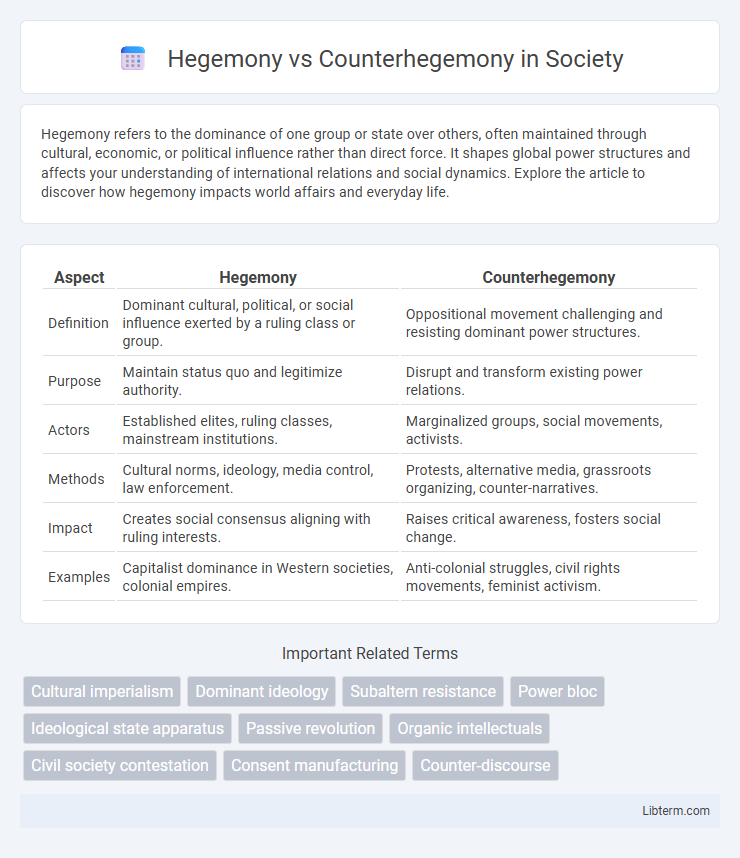Hegemony refers to the dominance of one group or state over others, often maintained through cultural, economic, or political influence rather than direct force. It shapes global power structures and affects your understanding of international relations and social dynamics. Explore the article to discover how hegemony impacts world affairs and everyday life.
Table of Comparison
| Aspect | Hegemony | Counterhegemony |
|---|---|---|
| Definition | Dominant cultural, political, or social influence exerted by a ruling class or group. | Oppositional movement challenging and resisting dominant power structures. |
| Purpose | Maintain status quo and legitimize authority. | Disrupt and transform existing power relations. |
| Actors | Established elites, ruling classes, mainstream institutions. | Marginalized groups, social movements, activists. |
| Methods | Cultural norms, ideology, media control, law enforcement. | Protests, alternative media, grassroots organizing, counter-narratives. |
| Impact | Creates social consensus aligning with ruling interests. | Raises critical awareness, fosters social change. |
| Examples | Capitalist dominance in Western societies, colonial empires. | Anti-colonial struggles, civil rights movements, feminist activism. |
Understanding Hegemony: Definition and Concepts
Hegemony refers to the dominance of one social group or nation over others through cultural, ideological, and political means rather than direct force. It involves establishing consent and shaping perceptions to maintain power structures, as articulated by theorist Antonio Gramsci. Understanding hegemony requires analyzing the subtle mechanisms by which ruling classes influence societal norms and values to secure their continued authority.
The Foundations of Counterhegemony
The foundations of counterhegemony rest on challenging dominant ideologies perpetuated by ruling classes through alternative narratives that empower marginalized groups. This resistance emerges by creating new cultural norms, values, and practices that disrupt existing power structures and promote social justice. Central to counterhegemony is the mobilization of collective consciousness aimed at transforming societal institutions and reclaiming political agency.
Historical Examples of Hegemonic Power
The British Empire exemplifies historical hegemonic power through its global dominance in the 19th century, controlling vast territories and influencing economic and political structures worldwide. The Roman Empire demonstrated hegemony by establishing extensive infrastructure and legal systems that integrated diverse regions under centralized authority. More recently, the United States asserted hegemonic influence in the post-World War II era by leading international institutions like the United Nations and shaping global economic policies.
Mechanisms of Maintaining Hegemony
Mechanisms of maintaining hegemony include control over cultural institutions, media, and education systems, which shape societal norms and values to support dominant power structures. Economic dominance and political influence reinforce consent among subordinate groups, reducing resistance by aligning their interests with the ruling elite. The use of ideology and discourse strategically legitimizes authority while marginalizing alternative perspectives, ensuring sustained social and ideological control.
Forms and Strategies of Counterhegemonic Movements
Counterhegemonic movements employ diverse forms such as grassroots activism, alternative media, and educational campaigns to challenge dominant cultural and political norms. These strategies prioritize building autonomous institutions, fostering collective identity, and leveraging social networks to mobilize marginalized groups against prevailing power structures. Emphasis on narrative reframing and direct action helps disrupt hegemonic discourses and create spaces for pluralistic expressions of power.
Media and Culture: Tools of Hegemonic Control
Media and culture function as pivotal tools in the exercise of hegemony by shaping public consciousness and reinforcing dominant ideologies. Through narratives, symbols, and representations, hegemonic power structures maintain social control by influencing perceptions of normalcy and legitimizing existing power relations. Counterhegemony emerges by contesting these dominant narratives, using alternative media and cultural expressions to challenge and disrupt hegemonic dominance.
Social Movements Challenging Dominant Narratives
Social movements challenging dominant narratives often engage in counterhegemony by actively resisting and undermining prevailing power structures established through cultural, political, and economic hegemony. These movements utilize alternative discourses, symbols, and practices to contest mainstream ideologies and mobilize marginalized communities, fostering social change and expanding democratic participation. Examples include civil rights movements, feminist activism, and environmental justice campaigns that disrupt hegemonic norms and promote pluralistic worldviews.
Global Perspectives on Hegemony and Counterhegemony
Global perspectives on hegemony highlight how dominant powers exert cultural, economic, and political influence to shape international norms and institutions, reinforcing global order aligned with their interests. Counterhegemony emerges through grassroots movements, alternative discourses, and regional alliances challenging the prevailing hegemonic structures by promoting diverse values and systemic change. These dynamics reflect ongoing struggles over power distribution, identity, and sovereignty in a multipolar world.
Impacts of Counterhegemony on Social Change
Counterhegemony challenges dominant power structures by promoting alternative ideologies and social practices, facilitating grassroots mobilization and empowering marginalized communities. This resistance disrupts established norms and creates space for new social relations, enabling progressive reforms and cultural shifts. The sustained impact of counterhegemony often results in transformative social change by redefining power dynamics and fostering inclusivity.
Future Trends: Evolving Dynamics of Power and Resistance
Future trends in hegemony and counterhegemony reveal shifting dynamics as global power structures become increasingly multipolar and digital resistance accelerates through social media platforms. Emerging technologies, such as artificial intelligence and blockchain, challenge traditional hegemonic control by enabling decentralized organization and empowering marginalized groups. This evolution signals a complex interplay between entrenched authority and innovative forms of dissent shaping both political and cultural landscapes worldwide.
Hegemony Infographic

 libterm.com
libterm.com